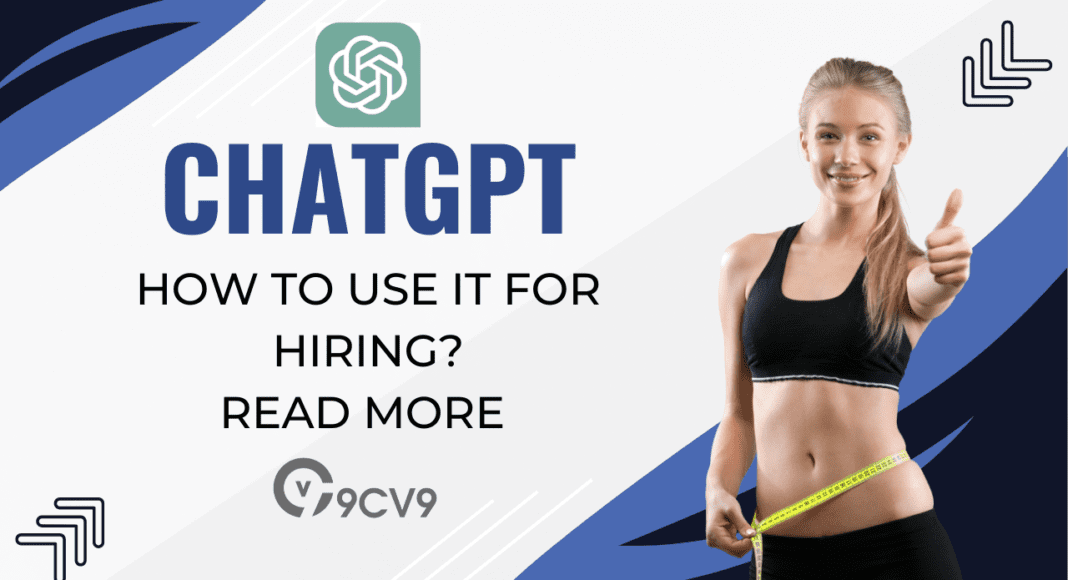In the current job market, finding the right candidate can be a time-consuming and often frustrating process for companies.
Sifting through hundreds of resumes, conducting multiple interviews, and evaluating candidates’ skills and experience can be daunting tasks.
Even wasting precious time and resources, which can be better used for other processes in the business.
This is where ChatGPT comes in.
As a natural language processing tool, ChatGPT can help companies automate and streamline various aspects of their hiring process, making it faster, more efficient, and ultimately more effective.
ChatGPT works by using machine learning algorithms to analyze large amounts of data and generate responses to questions posed to it in natural language.
As such, it can be trained to evaluate resumes and cover letters, screen candidates, conduct interviews, and even assist with onboarding and training.
ChatGPT can quickly and accurately assess candidates’ skills, experience, and fit for the role, allowing hiring managers to focus on the most qualified candidates.
The benefits of using ChatGPT for hiring are numerous.
It can save time and money by automating many of the tedious and time-consuming aspects of the hiring process, such as resume screening and initial interviews.
It can also help to reduce bias in the hiring process by using objective criteria to evaluate candidates.
Moreover, ChatGPT can help to enhance the candidate experience by providing a personalized and engaging recruitment process, thereby increasing your employer branding as well.
In this blog post, we will explore how to use ChatGPT for hiring and provide practical tips for companies looking to incorporate this technology into their hiring process.
We’ll cover everything from how to train ChatGPT for specific purposes to best practices for using it effectively.
Whether you’re a small business or a large corporation, ChatGPT can help you find top talent faster and more efficiently than ever before.
So, let’s dive in and learn more about this exciting technology and how you can use it to transform your hiring process.
Before we venture further into this article, we like to share who we are and what we do.
About 9cv9
9cv9 is a business tech startup based in Singapore with a strong presence all over the world.
With over six years of startup and business experience, and being highly involved in connecting with thousands of companies and startups, the 9cv9 team has listed some important learning points in this overview of how to use ChatGPT for hiring in 2023.
If your company needs recruitment and headhunting services, you can use 9cv9 headhunting and recruitment services to hire top talents and candidates. Find out more here, or send over an email to [email protected].
What is ChatGPT?

From our previous article in which we wrote a primer on ChatGPT, here are the best bits.
ChatGPT is a powerful language model that utilizes artificial intelligence (AI) to assist users with various tasks.
ChatGPT is based on the transformer architecture and is trained on a massive corpus of text data, allowing it to generate human-like responses to a wide range of prompts.
The transformer architecture was first introduced in 2017 and has since become one of the most popular models for NLP applications.
To train ChatGPT, OpenAI used a massive corpus of text data, including books, articles, and websites. This allowed the model to learn patterns and associations in language and generate more accurate responses over time.
One of the key ways that ChatGPT uses AI is through natural language processing (NLP), a branch of AI that focuses on enabling computers to understand and respond to human language.
ChatGPT uses NLP to analyze the context and intent of user input and generate appropriate responses in natural language.
Another way that ChatGPT uses AI is through machine learning (ML), a subset of AI that enables machines to learn from data and improve over time.
ChatGPT also utilizes deep learning, a type of ML that uses neural networks to model complex patterns and relationships in data.
This allows ChatGPT to generate more nuanced and sophisticated responses to user input.
ChatGPT is trained on vast amounts of text data, allowing it to learn patterns and associations in language and generate more accurate responses over time.
ChatGPT uses AI to assist with a wide range of tasks, including answering questions, generating text, completing tasks, and more.
Now, in this article, we will see how ChatGPT can be utilized for your company’s hiring needs.
One key aspect of ChatGPT is that it can be trained for specific purposes.
This means that businesses can customize ChatGPT to suit their specific needs, such as hiring.
By training ChatGPT on relevant data and using it to analyze text-based inputs related to hiring, companies can use the tool to automate and streamline many aspects of the hiring process.
Another important aspect of ChatGPT is its ability to learn from the data it processes.
As ChatGPT processes more data, it becomes more accurate and able to generate better responses to text-based inputs.
This means that as ChatGPT is used more frequently for hiring, it will become better at evaluating candidates and generating insights that can help hiring managers make more informed decisions.
How to use ChatGPT for Hiring in 2023
Using ChatGPT for hiring involves several steps, including training the tool, identifying relevant keywords, and integrating it into the hiring process.
Here is a step-by-step guide on how to use ChatGPT for hiring:
- Train the Tool: To use ChatGPT for hiring, companies should train the tool on relevant data and input, such as past successful hires, job descriptions, and industry-specific keywords. This can help to ensure that the tool is providing accurate and relevant information about each candidate. This might be technical and it’s best to involve your IT team or if not, get the help of top AI outsourcing company like AppLabx.
- Identify Relevant Keywords: Companies should identify relevant keywords related to the position and use them to train ChatGPT. This can help the tool identify resumes and cover letters that contain the most relevant information about each candidate’s qualifications.
- Use ChatGPT for Candidate Screening: After training the tool, companies can use ChatGPT for candidate screening, which involves inputting candidate information and letting ChatGPT analyze it to identify the most qualified candidates.
- Use ChatGPT for Interviews: ChatGPT can also be used to conduct interviews, either through text-based chat or voice-based interactions. This can provide a more consistent and objective interview process for each candidate.
- Use ChatGPT for Resume and Cover Letter Evaluation: ChatGPT can also be used to evaluate resumes and cover letters, providing a quick and accurate way to screen candidates.
- Use ChatGPT for Onboarding and Training: Finally, companies can use ChatGPT for onboarding and training new hires, providing a personalized and scalable solution for employee training and support.
Overall, using ChatGPT for hiring involves a combination of training the tool, identifying relevant keywords, and integrating it into each step of the hiring process.
By using ChatGPT for candidate screening, interviews, resume evaluation, and onboarding and training, companies can streamline their hiring process and find the best candidates for their teams.
For a quick tutorial on how to use ChatGPT generally (included for hiring as mentioned above), refer to this article on training your own ChatGPT model: A step-by-step tutorial.
Otherwise, we will recommend getting a professional outsourcing company like AppLabx, the world’s top AI software development company.
How ChatGPT can improve the hiring process
- Candidate Screening
- Interview
- Evaluating Resumes and Cover Letters
- Onboarding and Training New Hires
1. Candidate Screening

One of the most time-consuming aspects of the hiring process is candidate screening.
Companies must sift through hundreds of resumes and cover letters, searching for the most qualified candidates.
This process can be both tedious and overwhelming, often leading to missed opportunities and delayed hiring decisions.
Fortunately, ChatGPT can help automate and streamline the candidate screening process.
By training the tool on relevant data and using it to analyze resumes and cover letters, companies can quickly and accurately identify the most qualified candidates.
Benefits of using ChatGPT for candidate screening
- Speed: ChatGPT can process resumes and cover letters in a matter of seconds, allowing companies to screen candidates faster than ever before. This means that hiring managers can focus on the most qualified candidates and move them through the hiring process more quickly.
- Objectivity: ChatGPT evaluates candidates based on objective criteria, such as education and experience, rather than subjective factors such as race, gender, or appearance. This helps to reduce bias in the hiring process and ensure that all candidates are evaluated fairly.
- Accuracy: ChatGPT can accurately assess candidates’ skills and experience, providing hiring managers with a more complete picture of each candidate’s qualifications. This means that companies can make more informed hiring decisions and find the best candidates for their open positions.
- Consistency: ChatGPT applies the same evaluation criteria to all candidates, ensuring that each candidate is evaluated using the same standards. This helps to ensure that the hiring process is consistent and fair for all candidates.
Overall, using ChatGPT for candidate screening can help companies save time, reduce bias, and make more informed hiring decisions.
In the next section, we’ll explore how ChatGPT can be used for interviewing candidates.
2. Interview

ChatGPT can also be used to interview candidates, either as a preliminary step or as a way to augment traditional in-person interviews.
By using ChatGPT to interview candidates, companies can save time and reduce costs, while still gathering important information about each candidate’s qualifications.
Tips for using ChatGPT for interviewing candidates
- Customize the Questions: To ensure that the interview questions are relevant to the position and company culture, companies should customize the questions used by ChatGPT. This can be done by training the tool on relevant data or by manually inputting questions into the system.
- Use Open-Ended Questions: ChatGPT works best with open-ended questions that allow candidates to provide detailed responses. This can help companies to better understand each candidate’s skills, experience, and approach to problem-solving.
- Review Transcripts: After the interview is complete, companies should review the transcripts generated by ChatGPT. This can help to identify areas where the candidate excels and areas where they may need more development.
- Combine with In-Person Interviews: While ChatGPT can be used as a standalone interviewing tool, it can also be combined with traditional in-person interviews. This can provide hiring managers with a more complete picture of each candidate’s qualifications and allow for a more thorough evaluation of their skills and experience.
- Train the Tool: Like candidate screening, companies should train ChatGPT on relevant data and input to ensure that it is providing accurate and relevant information about each candidate.
Using ChatGPT for interviewing candidates can help companies save time and resources, while still gathering important information about each candidate’s qualifications.
By customizing the questions and reviewing transcripts, companies can make more informed hiring decisions and find the best candidates for their open positions.
3. Evaluating Resumes and Cover Letters

ChatGPT can also be used to evaluate resumes and cover letters, providing companies with a quick and accurate way to screen candidates.
Tips for using ChatGPT for evaluating resumes and cover letters
- Focus on Relevant Keywords: Companies should identify relevant keywords related to the position and use them to train ChatGPT. This can help the tool identify resumes and cover letters that contain the most relevant information about each candidate’s qualifications.
- Identify Red Flags: ChatGPT can help to identify red flags in resumes and cover letters, such as gaps in employment or inconsistencies in work experience. By using ChatGPT to identify these red flags, companies can quickly eliminate candidates who may not be a good fit for the position.
- Train the Tool: Like candidate screening, companies should train ChatGPT on relevant data and input to ensure that it is providing accurate and relevant information about each candidate. This can include past successful hires, job descriptions, and industry-specific keywords.
- Review Results: After ChatGPT has evaluated the resumes and cover letters, companies should review the results to ensure that the tool is accurately identifying the most qualified candidates. This can help to identify any areas where the tool may need additional training or adjustment.
- Combine with Human Review: While ChatGPT can provide a quick and accurate way to evaluate resumes and cover letters, it is still important to have a human review process in place. This can help to ensure that the tool is not eliminating qualified candidates and can provide a more comprehensive evaluation of each candidate’s qualifications.
Using ChatGPT for evaluating resumes and cover letters can help companies quickly identify the most qualified candidates for their open positions.
By focusing on relevant keywords and identifying red flags, companies can streamline their hiring process and find the best candidates for their teams.
And, if your side needs a top CV or Resume, then look no further than UrbanCV, the world’s most modern CV Builder powered by smart programming.
4. Onboarding and Training New Hires

In addition to candidate screening, interviewing, and resume evaluation, ChatGPT can also be used for onboarding and training new hires.
Benefits of using ChatGPT for onboarding and training
- Personalized Learning: ChatGPT can provide a personalized learning experience for each new hire, tailoring the training to their specific needs and learning style. This can help to ensure that each new hire is receiving the information and support they need to succeed in their new role.
- 24/7 Availability: ChatGPT is available 24/7, which means that new hires can access training and support at any time, even outside of regular business hours. This can help to ensure that new hires are able to learn and ask questions at their own pace and convenience.
- Cost-Effective: Using ChatGPT for onboarding and training can be a cost-effective solution, especially for smaller companies with limited resources. ChatGPT can provide high-quality training and support without the need for expensive training programs or dedicated trainers.
- Scalability: ChatGPT can be easily scaled to meet the needs of any size company, from small startups to large corporations. This can help companies to quickly onboard and train new hires, regardless of their size or hiring needs.
- Analytics: ChatGPT can provide valuable analytics on each new hire’s progress, including areas where they may need additional support or training. This can help managers to identify areas for improvement and ensure that each new hire is receiving the support they need to succeed.
Using ChatGPT for onboarding and training new hires can provide a personalized, cost-effective, and scalable solution for companies of all sizes.
By providing 24/7 availability and valuable analytics, ChatGPT can help companies to ensure that each new hire is receiving the support and training they need to succeed in their new role.
Best practices for using ChatGPT for hiring
To get the most out of ChatGPT for hiring, companies should follow best practices that can help them to use the tool effectively and make informed hiring decisions.
Here are some best practices for using ChatGPT for hiring:
- Use ChatGPT as a Supplement: While ChatGPT can be a powerful tool for hiring, it should be used as a supplement to human judgment, not a replacement for it. Companies should still review each candidate’s information and make hiring decisions based on a combination of factors.
- Train the Tool with Relevant Data: To ensure that ChatGPT is providing accurate and relevant information, companies should train the tool with data that is specific to the position they are hiring for. This can include past successful hires, job descriptions, and industry-specific keywords.
- Monitor Accuracy: Companies should monitor the accuracy of ChatGPT’s recommendations and adjust the training data as needed. This can help to ensure that the tool is providing reliable and relevant information.
- Use Clear Criteria: Before using ChatGPT for hiring, companies should set clear criteria for what they are looking for in a candidate. This can help to ensure that ChatGPT is providing information that is aligned with their hiring goals.
- Use Multiple Data Sources: Companies should use multiple data sources to make hiring decisions, including candidate experience, references, and cultural fit. ChatGPT should be used as one of several tools to help evaluate candidates.
- Provide Feedback to ChatGPT: Companies can provide feedback to ChatGPT on its recommendations, which can help to improve its accuracy and relevance over time.
- Ensure Compliance with Regulations: Companies should ensure that their use of ChatGPT complies with relevant regulations, such as those related to equal employment opportunities.
By following these best practices, companies can use ChatGPT for hiring in a way that is effective, ethical, and aligned with their hiring goals.
ChatGPT can be a valuable tool for streamlining the hiring process and identifying the best candidates, but it’s important to use it in combination with human judgment and other data sources.
When is ChatGPT not Useful for Hiring?
While ChatGPT can be a powerful tool for hiring, there are some areas where it may not be appropriate to use or may not be effective.
Here are some areas where ChatGPT may not be suitable for hiring:
- Legal Compliance: While ChatGPT can help streamline the hiring process, it may not be appropriate to use it for making decisions related to legal compliance, such as those related to equal employment opportunities. Companies should always ensure that their hiring decisions comply with relevant regulations.
- Personal Bias: ChatGPT is only as unbiased as the data it’s trained on. If the training data contains personal biases, ChatGPT may perpetuate those biases in its recommendations. Companies should ensure that the training data is diverse and representative of a range of perspectives.
- Complex Judgments: While ChatGPT can analyze large volumes of data and make recommendations based on that data, it may not be able to make complex judgments that require human intuition and understanding. For example, it may not be effective for assessing the creativity or problem-solving ability of a candidate.
- Cultural Fit: ChatGPT may not be able to evaluate a candidate’s fit with the company’s culture, which can be an important factor in making hiring decisions. Companies should use ChatGPT in combination with other data sources, such as interviews and references, to evaluate cultural fit.
ChatGPT can be a valuable tool for hiring, but it should be used in combination with human judgment and other data sources.
Companies should be aware of the areas where ChatGPT may not be appropriate or effective and use it accordingly.
Conclusion
In conclusion, ChatGPT can be a valuable tool for companies looking to streamline their hiring process and identify the best candidates.
By using ChatGPT for candidate screening, evaluating resumes and cover letters, and onboarding and training new hires, companies can save time and resources while making informed hiring decisions.
However, it’s important to use ChatGPT effectively and in combination with human judgment and other data sources.
By following best practices, such as training the tool with relevant data, setting clear criteria, and monitoring accuracy, companies can use ChatGPT for hiring in a way that is effective, ethical, and aligned with their hiring goals.
As technology continues to advance, ChatGPT and other AI tools are likely to play an increasingly important role in the hiring process.
By staying up-to-date on best practices and using these tools effectively, companies can stay competitive in the job market and attract top talent.
If you find this article useful, why not share it among your recruitment, human resource business partner, and talent acquisition counterparts, and also leave a nice comment below?
We, at the 9cv9 Research Team, strive to bring the latest and most meaningful data, guide, and statistics to your doorstep.
People Also Ask
How to use ChatGPT for your career?
ChatGPT can also be used for career-related purposes such as resume analysis, job search, and career planning. You can use it to analyze your resume and receive feedback on areas for improvement, explore potential job opportunities based on your skills and interests, and get insights into industry trends and career paths. Additionally, ChatGPT can help with interview preparation by providing sample questions and offering insights on what employers might be looking for in candidates. By leveraging the power of ChatGPT, you can enhance your career prospects and make informed decisions about your professional development.
How to use a Chatbot for recruitment?
Chatbots can be a valuable tool for recruitment by automating the initial screening and engagement process. You can use a chatbot to pre-screen candidates, answer their questions about the job and company, and schedule interviews. Additionally, chatbots can help with candidate engagement by sending personalized messages and updates about the hiring process, which can improve candidate experience and reduce time-to-hire. To use a chatbot effectively, you should design it with clear criteria and questions, train it on relevant data, and integrate it with your existing recruitment technology. By using chatbots for recruitment, you can improve efficiency, reduce costs, and enhance the overall candidate experience.
How to use AI in the hiring process?
AI can be used in the hiring process to streamline recruitment, improve candidate experience, and make data-driven hiring decisions. AI-powered tools such as ChatGPT can be used for candidate screening, evaluation, onboarding, and training, which can save time and resources while identifying top talent. Additionally, AI can help with candidate engagement by personalizing messaging, scheduling interviews, and providing updates on the hiring process. To use AI effectively in the hiring process, companies should ensure that the training data is diverse and representative, monitor accuracy and bias, and use AI in combination with human judgment and other data sources. By leveraging AI in the hiring process, companies can stay competitive in the job market and attract the best talent.
How to use AI in talent acquisition?
AI can be used in talent acquisition to optimize the recruitment process and identify top talent. AI-powered tools such as ChatGPT can analyze candidate data and provide insights on which candidates are the best fit for the job. Additionally, AI can help with candidate engagement by automating communication and personalizing messaging. AI can also be used to identify candidates who are more likely to stay with the company long-term and have a high potential for growth. To use AI effectively in talent acquisition, companies should ensure that the training data is diverse and representative, monitor accuracy and bias, and use AI in combination with human judgment and other data sources. By leveraging AI in talent acquisition, companies can attract and retain the best talent, reduce costs, and stay competitive in the job market.
Can anyone use ChatGPT?
Yes, anyone can use ChatGPT to generate natural language responses to various prompts or questions. However, it is important to note that ChatGPT is a tool that is designed to be used by developers and data scientists who have knowledge and experience in working with AI models. Additionally, the use of ChatGPT in specific industries, such as healthcare or finance, may require additional considerations and compliance with relevant regulations. As with any AI technology, it is important to be aware of the limitations and potential biases of ChatGPT and to use it responsibly and ethically.































![Writing A Good CV [6 Tips To Improve Your CV] 6 Tips To Improve Your CV](https://blog.9cv9.com/wp-content/uploads/2020/06/2020-06-02-2-100x70.png)


